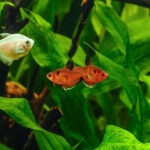How To Choose And Care For Freshwater Angelfish

Photo by Chewy
The beautiful and popular freshwater angelfish (Pterophyllum scalare) has been a staple of the aquarium hobby for more than 100 years. The first importations were recorded in the decade that preceded World War I and created quite a sensation, with aquarists referring to them as the “king” of aquarium fish. For many years, they simply called them “scalare.” The term angelfish became popular in the 1920s and soon became the common name that has remained to this day.
In the past decade or so, as the marine hobby became more prominent, some people started referring to them as “freshwater angelfish” to differentiate them from marine angelfish, but when most aquarists say “angel” or “angelfish,” they are referring to P. scalare. Amazingly, they still create quite a sensation to this day, drawing compliments out of folks who aren’t even aquarists. They have a stately bearing that seems to radiate graceful beauty. There’s just no other way to put it.
A Bit of Angelfish Science
The angelfish was first described as Pterophyllum scalare back in 1823. Throughout the years it was given a few other names, but today, nearly 200 years later, it is still known to science as P. scalare. The name describes the fish’s overall appearance—the stately dorsal and anal fins. The name translates roughly as “winged leaf with a staircase,” with the staircase bit referring to the escalating first rays of the dorsal fin. From around 1930 to the 1960s most authors called it Pterophyllum eimekei, but that is now considered a junior synonym of P. scalare. There are at least two other angelfish species that are sometimes imported—P. altum and P. leopoldi. In addition, there are scattered populations all over northern South America that may represent distinct subspecies or may eventually be described as full species in their own right. So while the species name has remained pretty constant for two centuries, it is still far from settled science.
Angelfish in the Wild
They are often found in flooded forest areas and around fallen trees in the main channel of slow-flowing streams. They’re not really designed to stay in the current. The striped pattern helps break up their silhouette among tangled branches, and from a distance, or at night, their outline looks like a floating leaf. In the wild, groups of P. scalare and another cichlid, the festivum (Mesonauta festivus), often hang around together. Their patterns and behaviors are remarkably similar. They are not necessarily schooling fish in the traditional sense, but they are social animals and like to be in groups in the same area.
Angels occur across a large area of northern South America, from French Guyana in the east to Peru in the west, and from Colombia in the north to Brazil in the south. Consequently, they are very adaptable and will thrive in most areas without the aquarist having to play chemist with the water parameters. A pH around or slightly below neutral with a water hardness of low to moderate will be just fine. While they are found in areas with slow water flow; the water is still low in dissolved organic matter, and they therefore like regular, large water changes in the aquarium. The water temperature ranges from the low 70s to the mid 80 degrees Fahrenheit in the wild, and hitting the middle of this range at 76 to 78 degrees in the home aquarium will be ideal.
Angelfish Tank Selection
As the angels grow, their dorsal and anal fin, along with their pelvic fins, will continue to grow longer and larger; these fish can easily reach a foot in height, so they require a deeper tank. An aquarium measuring at least 16 to 18 inches or taller is required, or their fins will not develop properly. I’ve seen many angels that have bent dorsals or damaged anal fins from being raised in too shallow a tank. A 20-gallon high would be the minimum size tank, and a 29-gallon tank would be even better to grow out a group of six to eight juveniles. If possible, shoot for a 55 or a 75-gallon for a similar group of adults.
Keep the bottom clean with regular maintenance and gravel vacuuming. For P. altum, a minimum tank size should be 30 inches deep, as they can easily grow to 20 inches or more in height.
Plants are not always found in the wild along with angels, but cover always is. Even though the fish you buy from a breeder or from the local fish store have never seen the wild, they will feel more comfortable in similar surroundings to what they would instinctively seek out in nature. Fill the tank with a tangle of driftwood and a pile of oak or beech leaf litter on the bottom and they will be happy. A canister filter is perfect for an angelfish tank, as they usually have a spray bar that allows a good volume of water flow without creating a torrent that would stress the angels. Large sponge filters also work well.
Angelfish Companions
Angels are stately, regal fish with a majestic bearing that is a nice contrast to small, schooling fish. However, remember that they are cichlids, and sometimes, despite that regal bearing, they will not be model community fish. They are not above eating smaller fish, such as neon tetras, guppies and similar-sized fish. Like all cichlids they will squabble amongst themselves and sometimes with other fish. Usually, no damage is done, but watch for a single fish being overly abused by its tankmates or for a pair deciding to spawn in a smaller tank where the rest of the fish don’t have any place to avoid the attention of the prospective parents.
As a rule, I generally try to stick with higher-bodied, mid-sized tetras of the genus Hyphessobrycon. Most Hyphessobrycon species, except for the group known as serpae tetras, are perfect companions for angels. Surface-dwelling hatchetfish and many killies are great choices. In a larger tank of 75 gallons or more, a group of festivums would be natural choices, as they often occur together in the wild. A pair or two of rams or kribensis would work as bottom-dwelling companions. Most catfish, especially Corydoras, Otocinclus and Ancistrus, are ideal companions as well. Many loaches, especially clown loaches, will make good tankmates. Some oddballs can make great companions. The African butterflyfish are a great choice and an interesting contrast. Leaf fish can make great companions, but they will eat smaller tank mates. Some smaller knifefish species, such as the black ghost knife and the green glass knife, can be excellent tank mates, as can some mormyrids like the elephant nose and the baby whale, but some individual specimens can be a bit nasty, so keep an eye on them for a few weeks and watch for rogue behavior. The same goes for larger gouramis.
Avoid fish like the Buenos Aires tetra, all Moenkhausia species tetras and all Astyanax species tetras, as they can be a bit nippy with angels. Many barbs fall into this category, too, especially tiger barbs. Other species of barbs, danios, rasboras, rainbowfish and similar fish are too busy and will stress the angels by their incessant darting about the tank.
Personally, I think nothing looks better than a species tank with a group of wild-colored adult angels swimming around a big pile of branches or branchy driftwood along with a few small clown plecos, a small school of Corydoras and maybe a couple pairs of rams.
Feeding Angelfish
Angels are primarily carnivores in the wild, so feed them regularly with meaty fish food, like frozen bloodworms, brine shrimp, mysis shrimp and similar fare. They should get a quality staple flake several times a week to balance out their diet. Many folks like to keep small shrimp in their tanks, and this is an excellent idea for an angelfish tank. Just remember that most of these small shrimp, plus all of their young, will wind up as food for the angels. If you want to enjoy the shrimp, maybe set up a separate shrimp tank and then move some of them to the angel tank as the population of shrimp becomes too large in their main tank.
Breeding Angelfish
No article on angels would be complete without some commentary on their breeding. Wild angels are notoriously difficult to spawn, even today. Aquarists who have bred the altum and Leopold angel are few and far between. On the other hand, the angels that most of us can get from local shops or from breeders are just the opposite. They are relatively easy to breed, and most of them make excellent parents, doing most of the work of raising the fry for us. There are literally dozens of articles and hundreds of videos online if you want to see more detail about breeding and raising the fry. You can buy what are called proven pairs, but these are often breeders just beyond their prime and sometimes they will never spawn again once they are moved.
Most breeders find it best to buy a group of juveniles and grow them out together, letting them choose their own mates. In a large tank, these pairs will form, spawn, raise a family and then break up, just like they do in the wild. In a smaller tank with no other companions, the pair will form and breed multiple times, raising multiple spawns together. This often works for several to a dozen or more spawns, but after a while the pair begins fighting and one or the other fish is either injured or killed. So after a few spawns, it is a good idea to mix things up by adding them to a larger tank, with or without other adult angels, just to give them a rest.
A World of Color
The wild freshwater angelfish is one of the most impressive of all wild freshwater fish. It can be nearly a foot tall and nearly 8 inches long, with its regal pattern of black stripes on a silver body. Depending on where they were collected, they can have brown, red, orange, rust, blue or even greenish highlights on the body. These colors are the source of the domestic variants that have been bred since the end of World War II. The fish in the hobby today are dozens of generations removed from the wild and are essentially domesticated fish like fancy goldfish or guppies. Their color and fin variants are beyond count, and every year something new and often spectacular appears.
The first color variant to appear around 1950 was the black lace angel, which was essentially a wild-type angel with more widespread black on the body and fins. This lead to the all-black angel a few years later, on which in the early days you could still see the black stripes, but soon a solid black body became the standard; this in turn lead to the marble angel, which had black blotching on a silver background. When veiltail appeared, it was bred into all the available colors.
All of these variants, plus the smoky, gold, all-silver (now sometimes called “platinum”) and even an albino variety were all widely available when the “African Invasion” began in the late 1960s, and many hobbyists dropped everything and began keeping the beautiful East African cichlids that poured in from Lakes Nyassa (now Lake Malawi) and Tanganyika. But a few angelfish enthusiasts continued to work with their beloved angels through the 1970s, and soon color variants such as blushing, half-black, chocolate, ghost, redcap and gold-marble appeared. The gold-marble strain has become so popular that now it is often simply called “marble” as the original silver-bodied marble angel has all but disappeared from the hobby.
In the 1980s, there were fewer new colors appearing, but now other mutations appeared, including the so-called “pearlscale” mutation, in which the body has a fine bumpy appearance that resembles the flanks being covered in pearls. Okay, you’ve got to have a good imagination to see that, but you’ve got to admit the person who came up with that name was a marketing genius. Calling them “lumpy” or something similar just wouldn’t have the same ring to it. Whatever you call it, the mutation is a popular one that to this day is available in every color and fin variant.
The freshwater angelfish is just as eye catching and just as popular today as it was a century ago when aquarists first laid eyes on them. I can’t wait to see what angel breeders turn up with next!
Mike Hellweg is a lifelong hobbyist who has turned his passion into his job. He has been active in aquarium hobby organizations for more than 30 years, is regularly invited to speak to clubs around the United States and Canada, writes regularly for hobby publications around the world and owns a small fish hatchery.



